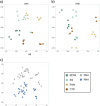Phylogenetic and Functional Diversity of Total (DNA) and Expressed (RNA) Bacterial Communities in Urban Green Infrastructure Bioswale Soils
- PMID: 28576763
- PMCID: PMC5541207
- DOI: 10.1128/AEM.00287-17
Phylogenetic and Functional Diversity of Total (DNA) and Expressed (RNA) Bacterial Communities in Urban Green Infrastructure Bioswale Soils
Abstract
New York City (NYC) is pioneering green infrastructure with the use of bioswales and other engineered soil-based habitats to provide stormwater infiltration and other ecosystem functions. In addition to avoiding the environmental and financial costs of expanding traditional built infrastructure, green infrastructure is thought to generate cobenefits in the form of diverse ecological processes performed by its plant and microbial communities. Yet, although plant communities in these habitats are closely managed, we lack basic knowledge about how engineered ecosystems impact the distribution and functioning of soil bacteria. We sequenced amplicons of the 16S ribosomal subunit, as well as seven genes associated with functional pathways, generated from both total (DNA-based) and expressed (RNA) soil communities in the Bronx, NYC, NY, in order to test whether bioswale soils host characteristic bacterial communities with evidence for enriched microbial functioning, compared to nonengineered soils in park lawns and tree pits. Bioswales had distinct, phylogenetically diverse bacterial communities, including taxa associated with nutrient cycling and metabolism of hydrocarbons and other pollutants. Bioswale soils also had a significantly greater diversity of genes involved in several functional pathways, including carbon fixation (cbbL-R [cbbL gene, red-like subunit] and apsA), nitrogen cycling (noxZ and amoA), and contaminant degradation (bphA); conversely, no functional genes were significantly more abundant in nonengineered soils. These results provide preliminary evidence that urban land management can shape the diversity and activity of soil communities, with positive consequences for genetic resources underlying valuable ecological functions, including biogeochemical cycling and degradation of common urban pollutants.IMPORTANCE Management of urban soil biodiversity by favoring taxa associated with decontamination or other microbial metabolic processes is a powerful prospect, but it first requires an understanding of how engineered soil habitats shape patterns of microbial diversity. This research adds to our understanding of urban microbial biogeography by providing data on soil bacteria in bioswales, which had relatively diverse and compositionally distinct communities compared to park and tree pit soils. Bioswales also contained comparatively diverse pools of genes related to carbon sequestration, nitrogen cycling, and contaminant degradation, suggesting that engineered soils may serve as effective reservoirs of functional microbial biodiversity. We also examined both total (DNA-based) and expressed (RNA) communities, revealing that total bacterial communities (the exclusive targets in the vast majority of soil studies) were poor predictors of expressed community diversity, pointing to the value of quantifying RNA, especially when ecological functioning is considered.
Keywords: 16S RNA; environmental microbiology; metagenomics; microbial ecology; soil microbiology; urban ecology.
Copyright © 2017 American Society for Microbiology.
Figures







Similar articles
-
Microbial Communities in Bioswale Soils and Their Relationships to Soil Properties, Plant Species, and Plant Physiology.Front Microbiol. 2019 Nov 20;10:2368. doi: 10.3389/fmicb.2019.02368. eCollection 2019. Front Microbiol. 2019. PMID: 31824435 Free PMC article.
-
Microbial Composition and Functional Diversity Differ Across Urban Green Infrastructure Types.Front Microbiol. 2020 Jun 5;11:912. doi: 10.3389/fmicb.2020.00912. eCollection 2020. Front Microbiol. 2020. PMID: 32582043 Free PMC article.
-
Mineral Types and Tree Species Determine the Functional and Taxonomic Structures of Forest Soil Bacterial Communities.Appl Environ Microbiol. 2017 Feb 15;83(5):e02684-16. doi: 10.1128/AEM.02684-16. Print 2017 Mar 1. Appl Environ Microbiol. 2017. PMID: 28003192 Free PMC article.
-
Microbial diversity and interactions in subgingival biofilm communities.Front Oral Biol. 2012;15:17-40. doi: 10.1159/000329669. Epub 2011 Nov 11. Front Oral Biol. 2012. PMID: 22142955 Review.
-
Advances in monitoring soil microbial community dynamic and function.J Appl Genet. 2020 May;61(2):249-263. doi: 10.1007/s13353-020-00549-5. Epub 2020 Feb 15. J Appl Genet. 2020. PMID: 32062778 Review.
Cited by
-
Framing the discussion of microorganisms as a facet of social equity in human health.PLoS Biol. 2019 Nov 26;17(11):e3000536. doi: 10.1371/journal.pbio.3000536. eCollection 2019 Nov. PLoS Biol. 2019. PMID: 31770370 Free PMC article.
-
Microbial Communities in Bioswale Soils and Their Relationships to Soil Properties, Plant Species, and Plant Physiology.Front Microbiol. 2019 Nov 20;10:2368. doi: 10.3389/fmicb.2019.02368. eCollection 2019. Front Microbiol. 2019. PMID: 31824435 Free PMC article.
-
Protist predation promotes antimicrobial resistance spread through antagonistic microbiome interactions.ISME J. 2024 Jan 8;18(1):wrae169. doi: 10.1093/ismejo/wrae169. ISME J. 2024. PMID: 39259188 Free PMC article.
-
A systematic scoping review reveals that geographic and taxonomic patterns influence the scientific and societal interest in urban soil microbial diversity.Environ Microbiome. 2025 Feb 4;20(1):17. doi: 10.1186/s40793-025-00677-7. Environ Microbiome. 2025. PMID: 39905522 Free PMC article. Review.
-
Tree Species Shape Soil Bacterial Community Structure and Function in Temperate Deciduous Forests.Front Microbiol. 2019 Jul 9;10:1519. doi: 10.3389/fmicb.2019.01519. eCollection 2019. Front Microbiol. 2019. PMID: 31338079 Free PMC article.
References
-
- Pickett ST, Cadenasso ML, Grove JM, Boone CG, Groffman PM, Irwin E, Kaushal SS, Marshall V, McGrath BP, Nilon CH, Pouyat RV, Szlavecz K, Troy A, Warren P. 2011. Urban ecological systems: Scientific foundations and a decade of progress. J Environ Manage 92:331–362. doi:10.1016/j.jenvman.2010.08.022. - DOI - PubMed
Publication types
MeSH terms
Substances
LinkOut - more resources
Full Text Sources
Other Literature Sources

